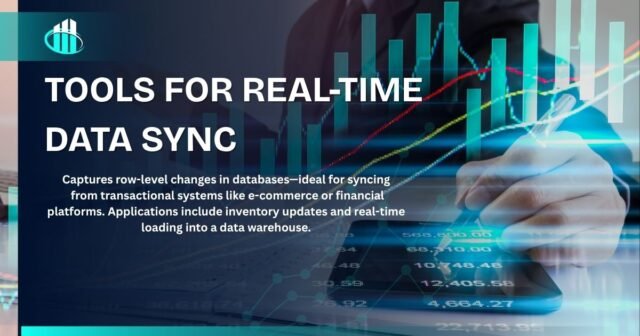In today’s data-driven world, real-time data synchronization isn’t just a convenience—it’s a necessity. Whether powering dynamic dashboards, enabling seamless user experiences, or maintaining cross-system consistency, using cutting-edge tools for real-time data sync can be a game-changer. This comprehensive guide explores top tools, their use cases, pros and cons, and how to choose the right one for your needs.
What Is Real‑Time Data Synchronization?
Real-time data synchronization refers to the automatic, near-instant update of data across different systems—databases, file storage, SaaS apps, cloud pipelines—triggered as soon as source data changes. Unlike batch ETL or scheduled sync, real-time sync minimizes data latency and significantly reduces error-prone manual processes.
Key benefits include:
- Zero latency: updates push through systems immediately
- Operational coherence: eliminates data silos and stale records
- Business agility: enables real-time decisions, alerts, and reporting
- Key Architectures & Technologies
Before diving into tools, let’s explore core synchronization methods:
1. Change Data Capture (CDC)
Captures row-level changes in databases—ideal for syncing from transactional systems like e-commerce or financial platforms. Applications include inventory updates and real-time loading into a data warehouse.
2. Event-Driven Streaming
Captures, processes, and routes events in real time using systems like Kafka, Storm, or Flink.
- Kafka: backbone for high-throughput streams
- Storm/Flink: real-time processing and event enrichment
3. File-Based Sync
Uses peer-to-peer protocols (e.g., Syncthing, Unison) or cloud services (OneDrive, Dropbox) for real-time file synchronization.
Top Real‑Time Data Sync Tools
1. Stacksync
Highlights: true bi-directional sync, sub-second latency, no-code setup, enterprise-grade compliance. Ideal for syncing CRMs and ERPs.
Use Cases: real-time syncing between Salesforce and NetSuite, inventory and billing updates.
Considerations: may exceed needs for small teams.
2. Apache Kafka / Kafka Streams
Strengths: exceptional performance and throughput, vast ecosystem.
Usage: complex event pipelines and distributed log sync.
Challenges: steep learning curve and operational complexity.
3. Apache Flink
Advantages: unified batch/stream processing, stateful event-time features, Python support.
Ideal For: large-scale event-driven pipelines with analytical processing.
Drawbacks: high resource demands and learning overhead.
4. Apache NiFi
Built For: flexible data routing, transformations, and ETL.
Features: visual UI, built-in version control, and over 300 connectors.
Benefits: great for ingestion and routing across sources.
Limitations: less optimal for ultra-high throughput, low-latency pipelines.
5. SymmetricDS
Open Source CDC tool for multi-master database sync (MySQL, PostgreSQL, Oracle, SQL Server).
Strengths: asynchronous sync with low bandwidth tolerance; schedule-friendly.
Best Suited For: distributed databases with intermittent connectivity.
6. Syncthing
Peer-to-peer file sync, open-source and secure, decentralized.
Ideal For: syncing files in private or development environments without a central server.
Note: only handles file-level sync, not structured databases.
7. Unison
Bi-directional file sync, efficient block-level transfers, cross-platform.
Best For: two-machine setups where file conflicts are manually reviewed.
Less Ideal: large-scale or automated synchronization scenarios.
Choosing the Right Tool
| Need | Recommended Tool(s) |
|---|---|
| Enterprise, bi-directional sync | Stacksync |
| Massive event streaming pipelines | Kafka + Flink |
| Flow-based ETL or data routing | NiFi |
| Open source DB sync (CDC) | SymmetricDS |
| Private file sync, peer-to-peer | Syncthing, Unison |
Key Selection Criteria:
- Type of data (file, database, event stream)
- Desired latency (sub-second vs scheduled updates)
- Scale and complexity requirements
- Compliance and security needs
- Budget and technical capacity
Best Practices for Real‑Time Sync
- Start Small: Begin with a single pipeline and scale gradually.
- Monitor Metrics: Track latency, throughput, and error/conflict rates.
- Governance: Implement error handling, alerting, and encryption layers.
- Scalable Design: Future-proof architecture for higher volumes and complexity.
- Audit Trails: Essential for compliance, recovery, and data integrity.
Real‑World Use Cases
- ERP + Sales Sync: Stacksync ensures orders appear instantly across systems.
- Log Analytics: Kafka → Flink pipelines feed dashboards and alert systems.
- Distributed File Sync: Syncthing manages logs or media across offices/devices.
- Database Replication: SymmetricDS replicates across geo-distributed PostgreSQL clusters.
Summary
Real-time data synchronization is critical for modern architectures. Choose tools based on:
- Data type: events vs structured data vs file systems
- Latency requirements: real-time vs near real-time vs scheduled
- Scale: single pipeline vs enterprise-grade streaming
- Compliance: encrypted, auditable, and governed systems
For seamless, enterprise-grade, two-way sync choose Stacksync.
For streaming analytics pipelines, Kafka + Flink is the ideal foundation.
For flexible ingestion and routing, NiFi offers unmatched versatility.
For open-source or peer-to-peer file syncing, consider SymmetricDS, Syncthing, or Unison.







